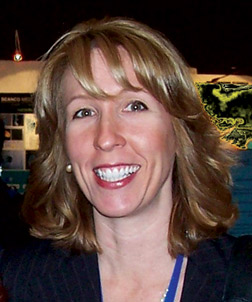Umbilical Cord Could Be New Source of Plentiful Stem Cells, Pitt Research Says
 Bridget M. Deasey
Bridget M. DeaseyStem cells that could one day provide therapeutic options for muscle and bone disorders can be easily harvested from the tissue of the umbilical cord, just as the blood that goes through the cord provides precursor cells to treat some blood disorders, said University of Pittsburgh School of Medicine researchers in the online version of the Journal of Biomedicine and Biotechnology.
Umbilical cord tissue cells can be expanded to a greater number, are remarkably stable, and might not trigger strong immune responses, said senior investigator Bridget M. Deasy, an assistant professor in the Department of Orthopaedic Surgery, Pitt School of Medicine. The cells are obtained from the gelatinous material in the cord known as Wharton’s jelly and from blood vessel walls.
“Our experiments also indicate that at least 21 million stem cells, and possibly as many as 500 million, could be banked from a single umbilical cord after the birth of a baby,” Deasy noted. “So, the cord could become an accessible source of a multitude of stem cells overcoming many of the restrictions, such as limited quantity as well as donor age and donor sex issues, that come with other adult stem cell populations.”
Deasy and her team analyzed sections of two-foot-long human umbilical cords that were donated for research, looking for cells in Wharton’s jelly and blood vessel walls that displayed the characteristic protein markers found in stem cells derived from other sources. The researchers then sought to find the best way to isolate the stem cells from the cords and tested them in the lab to confirm their ability to produce specialized cells, such as bone and cartilage, while retaining their invaluable ability to renew themselves.
To build on these findings, the team will test the umbilical cord stem cells in animal models of cartilage and bone repair, as well as in muscle regeneration.
The research was supported by grants from the National Institute of Arthritis and Musculoskeletal Research and Children’s Hospital of Pittsburgh of UPMC.
Other Stories From This Issue
On the Freedom Road

Follow a group of Pitt students on the Returning to the Roots of Civil Rights bus tour, a nine-day, 2,300-mile journey crisscrossing five states.
Day 1: The Awakening
Day 2: Deep Impressions
Day 3: Music, Montgomery, and More
Day 4: Looking Back, Looking Forward
Day 5: Learning to Remember
Day 6: The Mountaintop
Day 7: Slavery and Beyond
Day 8: Lessons to Bring Home
Day 9: Final Lessons

